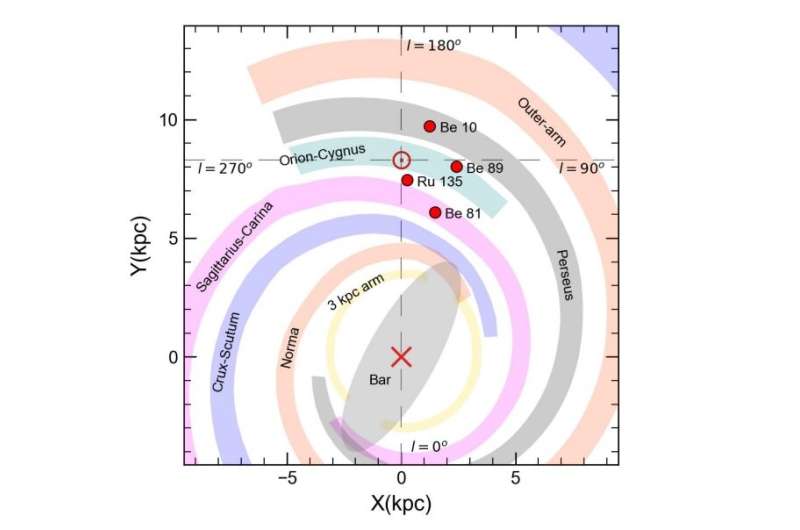April 26, 2022 report
Study inspects properties of four galactic open clusters

Using data from ESA's Gaia space observatory, astronomers from the Istanbul University in Turkey have inspected four galactic open clusters. Results of this research, available in a paper published April 16 on the arXiv pre-print repository, deliver important insights into the properties of these objects.
Open clusters (OCs), formed from the same giant molecular cloud, are groups of stars loosely gravitationally bound to each other. So far, more than 1,000 of them have been discovered in the Milky Way, and scientists are still looking for more, hoping to find a variety of these stellar groupings. Expanding the list of known galactic open clusters and studying them in detail could be crucial for improving our understanding of the formation and evolution of our galaxy.
Therefore, Turkish astronomers Hikmet Çakmaka and Yüksel Karataşa have examined four OCs in the Milky Way, namely: Berkeley 10 (or Be 10), Berkeley 81 (Be 81), Berkeley 89 (Be 89), and Ruprecht 135 (Ru 135). They analyzed photometric and astrometric data from Gaia Early Data Release 3 (EDR3) with the aim of determining astrophysical, structural and dynamical parameters of these clusters.
"In this paper, we study the dynamical evolution of Be 81, Ru 135, Be 10, and Be 89 from Gaia EDR3 photometric/astrometric data," the researchers wrote in the study.
The research found that the largest and most massive OC from the studied quartet is Be 89. It has a radius of about 37.1 light years and its total mass was calculated to be 154.7 solar masses. The cluster is 3.2 billion years old, has a metallicity of 0.0152, and is located some 7,900 light years away from the Earth. It is estimated that Be 89 has at least 221 member stars.
With a radius of about 5.5 light years and total mass of approximately 98.5 solar masses, Ru 135 is the smallest and least massive cluster out of the four described in the paper. At a distance of just 2,900 light years, Ru 135 has an age of about 1 billion years, metallicity similar to that of Be 89, and is estimated to contain 119 stars.
Be 81 is the most distant OC from the sample as it is located some 8,600 light years away. Its radius and mass are estimated to be 9.84 light years and 134.5 solar masses, respectively. The age of this cluster, known to host at least 171 stars, is estimated to be 1.6 billion years, while its metallicity is at a level of 0.024.
When it comes to 1.35 billion years old Be 10, it has a radius of about 21.2 light years and its total mass was calculated to be 109.6 solar masses. Located at a distance of 6,223 light years, this OC is estimated to have 197 member stars, and its metallicity was found to be approximately 0.008.
Summing up the results, the researchers noted that the cluster Be 89 expands with time, contrary to Be 10 and Be 81 as these two showcase the relatively shrinkage cluster radii due to dynamical evolution. In the case of Ru 135, it was found that instead of shrinking in size and mass with time, this cluster may have a primordial origin assumed to be related to high molecular gas density in galactic directions.
More information: Hikmet Çakmak, Yüksel Karataş, A Dynamical Evolution Study of the Open Clusters: Berkeley 10, Berkeley 81, Berkeley 89 and Ruprecht 135. arXiv:2204.07745v3 [astro-ph.GA], arxiv.org/abs/2204.07745
© 2022 Science X Network




















